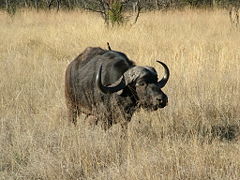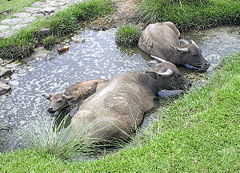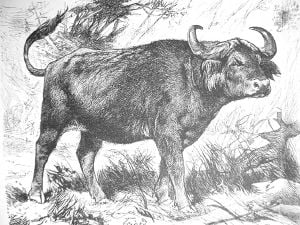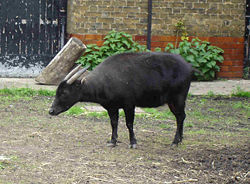Buffalo
In zoology, buffalo may refer to two particular bovines:
- African Buffalo (Syncerus caffer)
- Bubalus, a genus that includes the Water Buffalo
It is also used to refer to bison, a genus that includes the American Bison (commonly known as the American Buffalo), although technically bison are not buffalo.
African Buffalo
| African Buffalo Conservation status: Lower risk (cd) | ||||||||||||||
|---|---|---|---|---|---|---|---|---|---|---|---|---|---|---|
 African Buffalo | ||||||||||||||
| Scientific classification | ||||||||||||||
| ||||||||||||||
| Binomial name | ||||||||||||||
| Syncerus caffer (Sparrman, 1779) | ||||||||||||||
| Subspecies | ||||||||||||||
|
S. c. caffer |
The African Buffalo or Cape Buffalo (Syncerus caffer) is a bovid from the family of the Bovidae. It is up to 1.7 meters high, 3 meters long, and can reach a weight of 1000 kilograms. On average, an adult male stands about 1.5 m high at the shoulder and weighs 680 kg, while a female is 10 - 15 cm shorter and weighs between 500 - 600 kg.
The Cape Buffalo is not closely related to the Asian Water Buffalo, but its ancestry remains unclear. It is a very powerful creature, demanding respect from even a pride of lions when paths cross. Other than humans, they have few natural predators and are capable of defending themselves against (and sometimes killing) lions. Lions do kill and eat buffalo occasionally, but it typically takes multiple lions to bring down a single adult buffalo; fewer when it is injured or very old. The leopard and spotted hyena are a threat only to newborn calves. Crossbreeding with domestic cattle has had only limited success, and the African Buffalo remains a wild animal. Known as one of the "big five" in Africa, the Cape Buffalo can be a volatile and formidable beast, goring, trampling and killing several people a year. It is reputedly the most dangerous game animal, with the possible exception of the hippopotamus.
Cape Buffalo occur from open savannah to thickly wooded country, and wallow when the opportunity presents itself. They are found in Ethiopia, Somalia, Zambia, Zimbabwe, Namibia, Botswana, Mozambique, South Africa, Kenya and Tanzania.
The main herd consists of both sexes and all ages, though bachelor groups are also found. A male is recognizable by the thickness of his horns, and is called the "Boss." Bulls mature at eight years of age. Cows first calve at five years of age, after a gestation period of 11.5 months. Older bulls forced out of herds are commonly found in bachelor groups.
Bubalus
Bubalus is a genus of bovines, the English name of which is buffalo. Species that belong to this genus are:
- Subgenus Bubalus
- Water Buffalo, Bubalus bubalus
- Bubalus cebuensis (extinct)
- Tamaraw, Bubalus mindorensis
- Subgenus Anoa
- Lowland Anoa, Bubalus depressicornis
- Mountain Anoa, Bubalus quarlesi
Some zoologists split the Water Buffalo into two species.
Water buffalo
| Water Buffalo | ||||||||||||||||
|---|---|---|---|---|---|---|---|---|---|---|---|---|---|---|---|---|
 A family of Water Buffalo bathing in a sinkhole, Taiwan | ||||||||||||||||
| Scientific classification | ||||||||||||||||
| ||||||||||||||||
| Binomial name | ||||||||||||||||
| Bubalus arnee (Kerr, 1792) |
The Water Buffalo is a very large ungulate and a member of the bovine subfamily. The Arni or Wild Buffalo survives in the wild in Pakistan, India, Bangladesh, Nepal, Bhutan, Vietnam, China, Philippine, Taiwan, Indonesia, and Thailand. The domestic Buffalo are very widespread in Asia, South America, North Africa and Europe. They are feral in northern Australia. Wild-living populations also exist in much of South-east Asia but their origins are uncertain. They may be descendants of wild Water Buffalo, formerly domesticated ferals or a mixture. In Asia, the population of wild Water Buffalo has become sparse, and there is fear that no pure-bred wild water buffalo exists. Adult Water Buffalo range in size from 300 kg to 600 kg for the domestic bred, but true wild water buffaloes can grow larger. Adult females typically weigh around 800 kg, and males up to 1200 kg. The average weight of an adult male is 900 kg, and the average height at the shoulder is about 1.7m. One distinction between wild buffaloes and domesticated version is that the wild species lacks the round belly found in domesticated buffalo. Due to interbreeding with feral and domestic species, weights can vary greatly even in populations which are in in close proximity. Interbreeding with domesticated buffaloes is the major cause of extinction of wild buffaloes. Buffaloes are believed to have originated in South Asia.
The classification of the Water Buffalo is uncertain. Some authorities list a single species, Bubalus bubalis with three subspecies, the River Buffalo (B. bubalis bubalis) of South Asia and the Carabao or Swamp Buffalo (B. bubalis carabanesis) of the Philippines and Southeast Asia, and the Arni, or Wild Buffalo, (B. bubalis arnee). Others regard these as closely-related, but separate, species. The Swamp Buffalo is primarily found in the eastern half of Asia and has 48 chromosomes. The River Buffalo is mostly found in western half of Asia, and has 50 chromosomes. Fertile offspring occur between the two. It does not readily hybridise with cattle which have 60 chromosomes.
Domestic animal expert Juliet Clutton-Brock wrote (Clutton-Brock 1999):
- More than half the people of the world depend on rice for their staple diet and it is the water buffalo that enables rice to be cultivated and threshed with the greatest efficiency and economy.
Milk from both of these animals is used by many human populations, and is the traditional raw material for mozzarella cheese and curd due to its higher fat content. The chief dairy breed of Buffalo is the Murrah breed. Buffalo meat, sometimes called "Carabeef", is often passed off as beef in certain regions and is also a major source of export revenue for India which has the largest population of buffaloes in the world. However, in many Asian regions, buffalo meat is less preferred due to its toughness. Water buffalo hide provides a tough and useful leather often used for shoes and motorcycle helmets.
Buffaloes, apart from its use as draught and milch animals, are also used to pull bullock carts in developing world. Their dung is used as a fertilizer and as a fuel when dried. Sometimes, people will also race on buffaloes, though riding them can be very difficult. A few have also found use as pack animals carrying loads even for special forces.
Asia. Asia is the native home of the water buffalo, with 95% of the world population of water buffalo. Many Asian countries depend on the water buffalo as its primary bovine species. It is valuable for its meat and milk as well as the labour it performs. As of 1992 the Asian population was estimated at 141 million. The fat content of buffalo milk is the highest amongst farm animals and the butterfat is a major source of ghee in some Asian countries. Its success in Asia is evident by its extensive range. Both variants occur in Asia. River Buffalo are found in elevations of 2,800 m in Nepal, and Swamp Buffalo are found throughout the lowland tropics. Part of their success is due to their ability to thrive on poor foodstuffs and yet be valuable economically. Moreover they are much better suited to plough the muddy paddy fields as they are better adapted than common cattle (Bos taurus) to move in swamps.
In the wild, very few pockets of buffalo exist. The Indian wild buffalo is found in India, Pakistan, Bangladesh, Nepal, Bhutan and Thailand. This buffalo has the largest horns of any living animal. The average spread is about 1 m (3 ft 3 in), but one bull shot in 1955 had horns measuring 4.24 m (13 ft 11 in) from tip to tip along the outside curve across the forehead. These massive battering rams protect the beast in the wild efficiently enough that even its predator seldom attacks a fully grown male. Tiger is their only predator, which can kill a full-grown male weighing 1000-1200kg, but only an experienced tiger will take them on, often by hamstringing their hind legs first. When faced by a tiger, they form a line facing the predator and charge with noses out and horns laid back. Like its other family members, the tamaraw and the anoa, the wild buffalo is a very dangerous animal known to charge without being provoked. Together with its large size, this bad temper makes wild water buffalo the most dangerous bovine on earth to humans. It is generally found in swamplands and grass jungles and moves in herds.
Today, the estimated population of wild water buffaloes are about 4000, but, this number takes into account all wild population, including feral herds and hybrid buffaloes. In fact, it is possible that no true wild specimens exist anymore.
The water buffalo, or "Carabao," is the national animal of the Philippines.
Australia. Introduced into the Northern Territory early in the 19th century as a beast of burden, it quickly escaped and is now feral. As a result of its feral status it may be hunted. Melville Island is a popular hunting location, where a steady population of up to 4,000 individuals exist. Buffaloes are also found in Arnhem Land and the Top End. Safari outfits run out of Darwin to Melville Island and other locations in the Top End often with the use of bush pilots. The government has unsuccessfully attempted several eradication programs. The buffaloes live mainly in freshwater marshes and billabongs, and their range can be quite expansive during the Wet season. They have developed a different appearance from the Indonesian buffaloes from which they descend.
Europe and Middle East. Introduced into North Africa and the Near East by 600 C.E., the water buffalo was brought to Europe with returning Crusaders in the Middle Ages, and herds can be found in Bulgaria and Italy. As in Asia, buffaloes of the Middle East and Europe live on coarse vegetation on the marginal land traditionally available to peasants. They are an economic asset by serving as a protein source, draft animal, and storage of family or household wealth. In some areas, they also provide occasional recreation at annual racing festivals. These buffalo are mostly River Buffaloes; due to genetic isolation have adopted a distinct appearance. Buffalo milk is used in Italy and elsewhere for the production of cheese, including mozzarella.
Tamaraw
The Tamaraw (Bubalus mindorensis; previously Anoa mindorensis), Tamarao or Mindoro Dwarf Buffalo is a bovine endemic to the island of Mindoro in the Philippines. It is believed, however, to have once also thrived on the greater island of Luzon. It was originally found all over Mindoro, from sea level up to the mountains, but because of human habitation, hunting, and logging, it is now restricted to only a few remote grassy plains and is now an endangered species.
Contrary to common belief and past classification, the Tamaraw is not a subspecies of the local Carabao, which is only slightly larger, or the common Water Buffalo. In contrast to the Carabao, it has a number of distinguishing characteristics: it is slightly hairier, has light markings on its face, is not gregarious, and has shorter horns that are somewhat V-shaped.
Though the national animal of the Philippines is the Carabao, the Tamaraw is closely considered a national symbol of the Philippines. It symbolizes sturdiness amidst a small frame, which most Filipinos possess. An image of the Tamaraw could be found on the 1980 to early 1990 One-Peso coins.
During the wake of the Asian van popularity in 1990s, Toyota Motors released an Asian van called Tamaraw FX in the Philippines. It was widely patronized by taxi operators and was immediately turned into a staple mode of transportation much like a cross of the taxi and the local jeepney.
The tamaraw is also the mascot of the varsity teams of the Far Eastern University (FEU Tamaraws) in the University Athletics Association of the Philippines, and of the Toyota Tamaraws of the Philippine Basketball Association.
Anoa
There are two species of anoa: the Mountain Anoa (Bubalus quarlesi) and the Lowland Anoa (Bubalus depressicornis). Both live in undisturbed forest, and although they are essentially miniature Water Buffalo, are similar in appearance to a deer, weighing 150–300 kg (330–660 lb).
Both are found on the island of Sulawesi in Indonesia; the Mountain Anoa is also found on the nearby island of Butung. They apparently live singly or in pairs, rather than herds, except when the cows are about to give birth. One young is born per year.
Both species of anoa have been classified as endangered since the 1960s and the population continues to decrease. It is believed unlikely that there are more than 5000 animals of each species remaining. Reasons for the decline of the anoa include hunting for hide, horns and meat by the indigenous peoples (though they were rarely hunted by indigenous peoples before the introduction of modern firearms); and loss of habitat due to the advancement of settlement. Currently, hunting is the more serious factor in most areas. The anoa do not appear to be adaptable to humans.
Mountain Anoa are also known as Anoa de Montana, Anoa de Quarle, Anoa des Montagnes, Anoa Pegunungan, and Quarle's Anoa. Lowland Anoa are also known as Anoa de Ilanura or Anoa des Plaines.
Lowland Anoa stands but little over a yard at the shoulder, and is the most diminutive of all wild cattle. It is nearly allied to the larger Asiatic buffaloes, showing the same reversal of the direction of the hair on the back. The horns are peculiar for their upright direction and comparative straightness, although they have the same triangular section as in other buffaloes. White spots are sometimes present below the eyes, and there may be white markings on the legs and back; and the absence or presence of these white markings may be indicative of distinct races. The horns of the cows are very small. The nearest allies of the anoa appear to be certain extinct buffaloes, of which the remains are found in the Siwalik Hills of northern India. In habits the animal appears to resemble the Indian buffalo.
ReferencesISBN links support NWE through referral fees
- Clutton-Brock, J. 1999. A Natural History of Domesticated Mammals. Cambridge UK : Cambridge University Press. ISBN 0521634954.
- Huffman, B. 2006. The ultimate ungulate page. UltimateUngulate.com. Retrieved December 26, 2006.
- Nowak, R.M. and Paradiso, J.L. 1983. Walker's Mammals of the World. Baltimore, Maryland, USA: The Johns Hopkins University Press. ISBN 0801825253
- Raudiansky, S. 1992. The Covenant of the Wild. New York: William Morrow and Company, Inc. ISBN 0688096107.
- Voelker, W. 1986. The Natural History of Living Mammals. Medford, New Jersey, USA: Plexus Publishing, Inc. ISBN 0937548081.
- Hedges 2000. [1]. 2006 IUCN Red List of Threatened Species., World Conservation Union. Retrieved on 11 May 2006. Database entry includes justification for why this species is critically endangered
- Guinness Book of Records, 2005
- Antelope Specialist Group 1996. [2]. 2006 IUCN Red List of Threatened Species., World Conservation Union. Retrieved on 11 May 2006.
External links
- http://www.nature-wildlife.com/buftxt.htm
- Cape Buffalo (Syncerus caffer caffer) facts and photography - Wild Animals Online encyclopedia
Credits
New World Encyclopedia writers and editors rewrote and completed the Wikipedia article in accordance with New World Encyclopedia standards. This article abides by terms of the Creative Commons CC-by-sa 3.0 License (CC-by-sa), which may be used and disseminated with proper attribution. Credit is due under the terms of this license that can reference both the New World Encyclopedia contributors and the selfless volunteer contributors of the Wikimedia Foundation. To cite this article click here for a list of acceptable citing formats.The history of earlier contributions by wikipedians is accessible to researchers here:
The history of this article since it was imported to New World Encyclopedia:
Note: Some restrictions may apply to use of individual images which are separately licensed.


